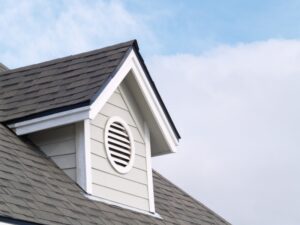What exactly makes up the roof of a house? It’s easy to think of the roof as a single object, something that goes in place all in one piece.
But roofs are actually systems made up of different parts. In this post, we’ll look at the anatomy of a roof to help you understand the different components and layers and how they work together.
The Roof Deck/Roof Sheathing
This is the basic layer of the roof system. It forms the structural foundation, and it’s usually made of boards of plywood. If the roof deck suffers from heavy damage, it often requires replacing the entire roof.
Roofing Underlayment
This is a material layer placed on top of the roof deck and beneath the shingles. The purpose of this underlayment is to provide extra protection against water seeping through the shingles and damaging the roof deck.
The current most popular material for roofing underlayment is synthetic, which replaced felt because of its superior water resistance and longevity.
Starter Shingles
Above the roofing underlayment goes a set of shingles designed to place protective material between the joints of the main layer of shingles that will go above them.
The starter shingles seal to the edge of the roof to help improve roof resistance against wind damage. If the wind can’t get its “fingers” under the edge of the roof, it can’t do as much damage.
Actual Shingle Layer
Over the starter shingles goes the layer of the “actual” shingles—i.e. the shingles visible to people looking at the roof.
There are many types of shingle materials available, such as the simple 3-tab shingles that fit together in a flat layer.
The most popular shingle type is architectural shingles, which contain multiple layers of asphalt shingles adhered together to give them greater dimension and durability.
Other Material
Shingles aren’t the only type of final layer for a roof. Other options include metal roofing, slate, and wood shingles.
If you’re interested in purchasing a new roof, feel free to ask our experts about the various material options and the different benefits and drawbacks of each.
Flashing
You’ve probably heard this term but not understood what it means regarding a roof. Flashing is the metal material placed at joint openings and around roof accessories such as skylights, chimneys, vents, and windows to help prevent water from finding another way beneath the roof.
Dormer
This is any raised section of the roof that protrudes beyond the plane of the roof. Dormers help create space underneath them and are common locations for windows (i.e. dormer windows).
Ridge Vent
This is an exhaust vent along the roof peak that helps to ventilate the attic of warm and humid air. Allowing this air to escape helps a roof to last longer because it prevents the development of mold and wood rot.
Our team are experts at all aspects of roofing, from shingles to the underlayment and all the accessories and parts between. Rely on us for your roof services in Richmond, TX.
Reign Roofing Is Redefining the Roof Buying Process! Contact us today to schedule service to install or repair your roof.

